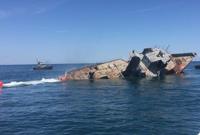DELAWARE.NEW JERSEY COASTS- After a storied career that included the Battle of Iwo Jima and the "Perfect Storm," the Zuni Tamaroa is now serving as an artificial reef.
The Delaware Department of Natural Resources AND Environmental Control, in partnership with New Jersey’s Department of Environmental Protection, sunk the ship Wednesday morning. After the ship was emptied of all oil and interior objects, crews from Coleen Marine drilled holes in the ship and gradually pumped it with water so it would sink upright, making it ideal for divers. Tim Mullane, vice president of operations at Coleen Marine, led the sinking, and says they purposely did not use explosives.
"If there were dolphins, sea turtles, or whales within miles of here, the explosive shock waves would've damaged them," he explained.
DNREC Artificial Reef Program Manager Jeff Tinsman said the reef will help marine wildlife in the state, as Delaware doesn't have natural reefs like coral reefs in Florida or rocky reefs in New England. According to Tinsman, small fish live in the reef, and attract larger fish like tuna as well.
"It certainly served very well during its 74 years so far," he said. "Now we are ready for another 100 or 200 years in retirement on the bottom serving fish communities."
Tinsman said fish begin living in the reef within hours of the sinking.
The Zuni Tamaroa sunk 125 feet below the surface and joined other military vessels in the Del-Jersey-Land Reef such as the former Army freighter turned Navy support ship Shearwater, the minesweeper Gregory Poole, and the 563-foot destroyer U.S.S. Arthur W. Radford , which DNREC says is the largest vessel ever deployed off the East Coast as an artificial reef. DNREC said this reef was established 10 years ago specifically for reefing former military vessels.
Tinsman said plans were originally in place to restore the Zuni Tamaroa, but its hull wasn't strong enough. , led the sinking and says seeing the ships recycled does them justice.
"I think this is a proper burial," he said. "We've sunk a number of tugs that have worked in the harbors of the East Coast, docking ships, building our country [...] Making them into artificial reefs is a fitting purpose for them."
Delaware paid for 75 percent of the sinking, with the funding from The Federal Aid in Sport Fish Restoration program administered by the US Fish & Wildlife Service. New Jersey provided 25 percent in matching funds from The Fisherman Magazine’s Sportfishing Fund.
Divers who wish to visit the site can use the coordinates 38° 31.200’N 074° 30.700’W.
To learn more on Delaware’s artificial reef program, click here.







